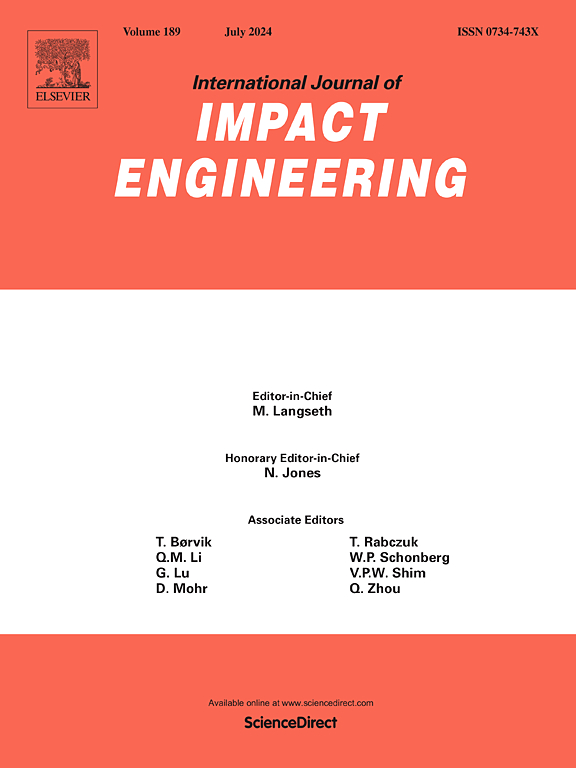Research on the damage effects of buried explosions concerning the crater size and peak wave
IF 5.1
2区 工程技术
Q1 ENGINEERING, MECHANICAL
International Journal of Impact Engineering
Pub Date : 2025-06-14
DOI:10.1016/j.ijimpeng.2025.105410
引用次数: 0
Abstract
The study of the damage effects resulting from the explosions of cylindrical charges holds significant importance in both military and civilian fields. In contrast to spherical charges, the explosive characteristics of the cylindrical charge exhibited spatial irregularities. To comprehensively quantify the influences of borehole diameter and buried depth on the damage effects, including the crater size and stress wave, experimental and numerical investigations on explosions induced by cylindrical charge are carried out in this paper. Firstly, a set of tests is conducted to provide fundamental data. Then, based on the meshfree method of Smoothed Particle Galerkin (SPG) and the K&C model, the variations in crater dimensions and the peak stress are fully simulated with a range of borehole diameters and buried depths. Finally, the influence of borehole and buried depth on the coupling factor is discussed. Both the buried depth and the borehole diameter impact the utilization of blast energy enormously. Furthermore, materials with distinct impedance values exert an influence on the distribution of the stress wave. Following the dimensional analysis, several empirical formulae expressing the crater size and peak stress are established, all of which can predict explosion damage rapidly and accurately.
考虑弹坑大小和峰值波的埋地爆炸破坏效应研究
研究圆柱形装药爆炸的损伤效应在军事和民用领域都具有重要意义。与球形装药相比,圆柱形装药的爆炸特性表现出空间不规则性。为了全面量化钻孔直径和埋深对弹坑大小和应力波等损伤效果的影响,本文对圆柱装药爆炸进行了实验和数值研究。首先,进行了一组测试以提供基础数据。然后,基于SPG (Smoothed Particle Galerkin, SPG)无网格方法和K&;C模型,在一定范围的钻孔直径和埋深下,全面模拟了火山口尺寸和峰值应力的变化。最后讨论了钻孔和埋深对耦合系数的影响。埋深和钻孔直径对爆破能的利用都有很大影响。此外,不同阻抗值的材料对应力波的分布也有影响。在量纲分析的基础上,建立了弹坑尺寸和峰值应力的经验公式,可以快速准确地预测爆炸损伤。
本文章由计算机程序翻译,如有差异,请以英文原文为准。
求助全文
约1分钟内获得全文
求助全文
来源期刊

International Journal of Impact Engineering
工程技术-工程:机械
CiteScore
8.70
自引率
13.70%
发文量
241
审稿时长
52 days
期刊介绍:
The International Journal of Impact Engineering, established in 1983 publishes original research findings related to the response of structures, components and materials subjected to impact, blast and high-rate loading. Areas relevant to the journal encompass the following general topics and those associated with them:
-Behaviour and failure of structures and materials under impact and blast loading
-Systems for protection and absorption of impact and blast loading
-Terminal ballistics
-Dynamic behaviour and failure of materials including plasticity and fracture
-Stress waves
-Structural crashworthiness
-High-rate mechanical and forming processes
-Impact, blast and high-rate loading/measurement techniques and their applications
 求助内容:
求助内容: 应助结果提醒方式:
应助结果提醒方式:


